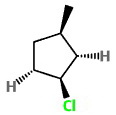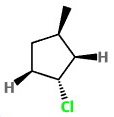What are the major products for reaction with cis-1-chloro-3-methylcyclopentane and trans-1-chloro-3-methylcyclopentane with #"OH"^(-)# in water at high temperature?
1 Answer
The cis isomer will form 3- and 4-methylcyclopentene in roughly equal amounts. The trans isomer will form 4-methylcyclopentene as the major product.
Explanation:
What type of reaction?
I predict an
- The substrate is a secondary alkyl halide.
- The substrate has at least one β-hydrogen: possible elimination.
- The nucleophile (
#"OH"^"-"# ) is a strong base: possible elimination. - There is (presumably) a high base concentration: favouring
#"E2"# . - Water is a polar protic solvent: favouring elimination.
- The high temperature favours elimination.
cis-1-Chloro-3-methylcyclopentane
The structure of the substrate is

Elimination requires a trans arrangement of the β-hydrogen and the leaving group.
We see appropriate β-hydrogens at
Elimination of the hydrogen from

Elimination of the hydrogen from

These two isomers would probably be formed in roughly equal amounts.
trans-1-Chloro-3-methylcyclopentane
The structure of the substrate is

Again, we see trans β-hydrogens at
However, elimination will be slower in each case because of steric hindrance by the methyl group.
Elimination of the hydrogen from
Thus, the major product will be 4-methylcyclopentene.

